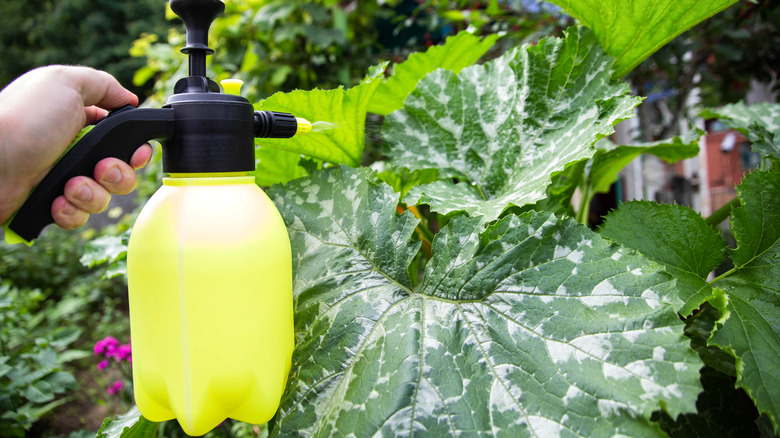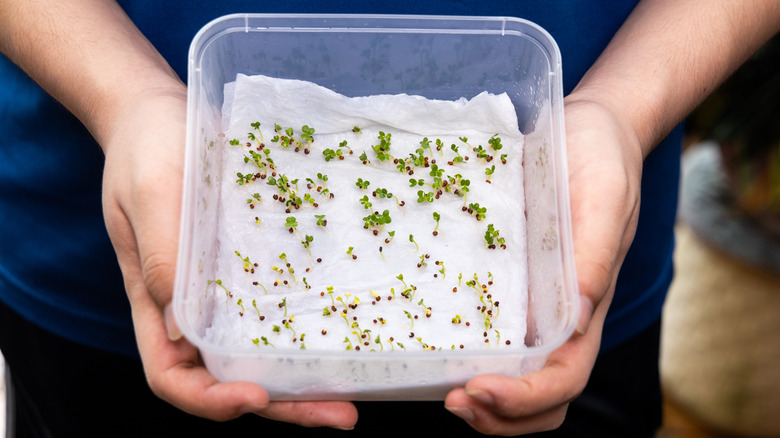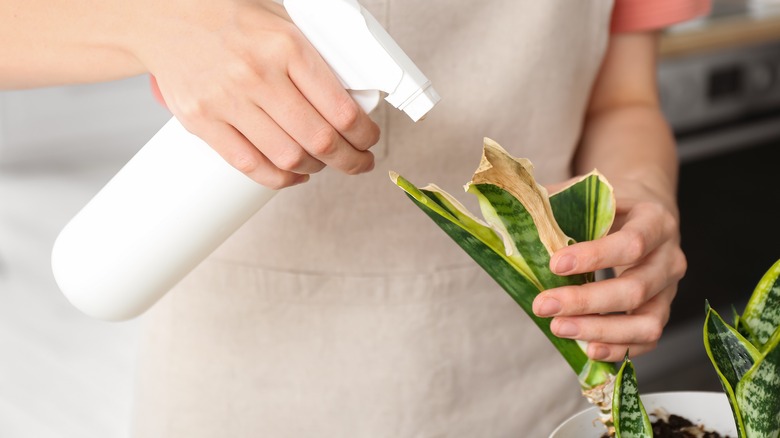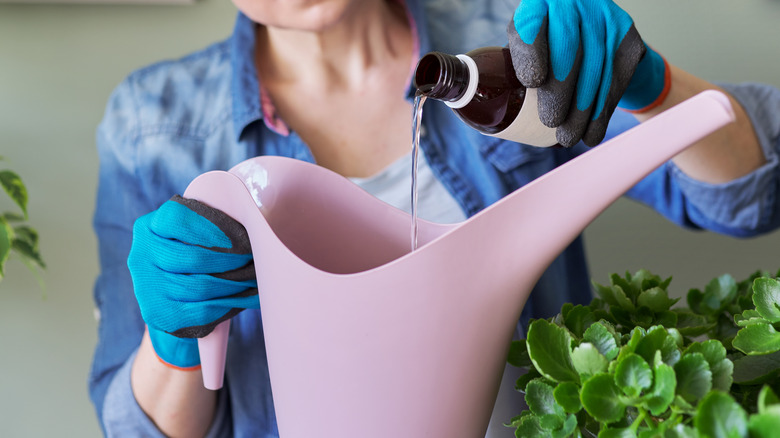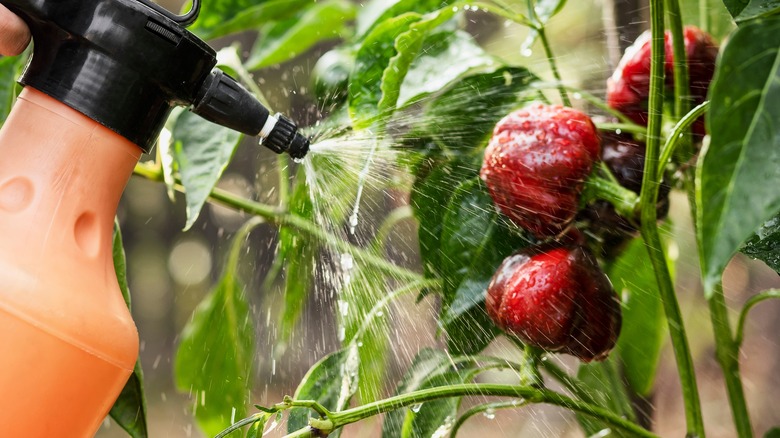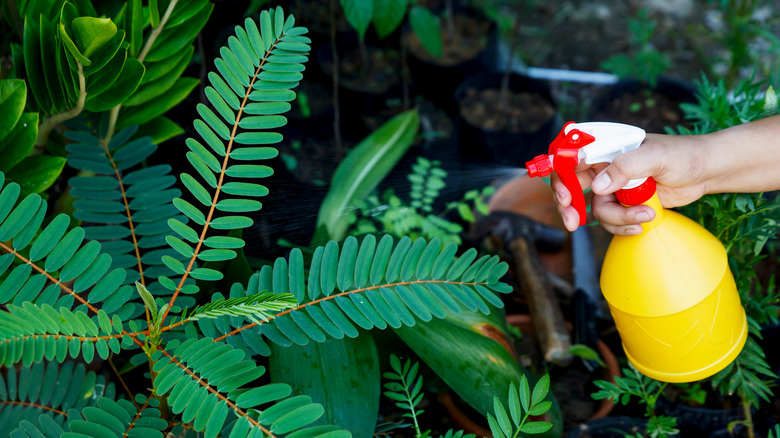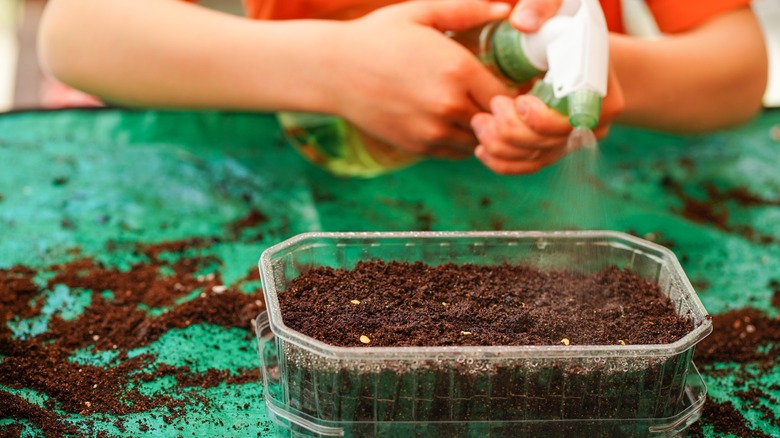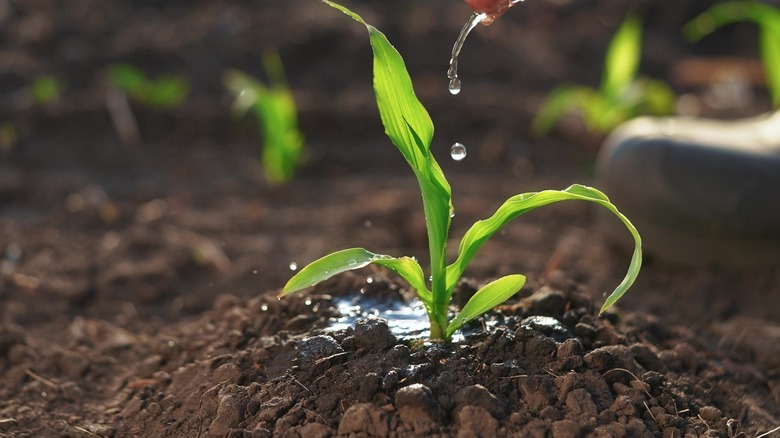It's Time To Stop Believing Some Hydrogen Peroxide Garden Myths
We may receive a commission on purchases made from links.
Hydrogen peroxide is a staple for many gardeners and houseplant parents, and with good reason. Not only is it cheap and easy to find, but with so many brilliant ways to use hydrogen peroxide in your garden, it's clear there are some serious horticultural benefits. A 2018 study in the "International Journal of Molecular Sciences" found certain dosage levels of H2O2 in plants resulted in an increased ability to handle drought and temperature stresses, improved growth and hormonal regulation in plant cells, and stronger cells in the stomata, roots, and shoots.
However, hydrogen peroxide is not a cure-all for plants, and some of its benefits have been mischaracterized so much that they barely resemble the original facts. So that's what we want to dive into and separate the myths from facts, so that you know what's true and what's a result of too many people playing a gardener's version of "The Telephone Game" with science. Unfortunately, there are things you should never do with hydrogen peroxide in your home and garden that can cause permanent damage to your plant's health, so learning the difference between TikTok's version of the truth and scientifically-backed reality will ensure your garden gets all the goodies H2O2 can offer, without suffering potential ramifications that came from bad, even if well-intentioned, information.
Myth: Using hydrogen peroxide guarantees seed germination
Let's start with a "technically true" factoid that's veered so far off course that it's now firmly in the "myth" category. When planting seeds, obviously, you'll do anything you can to ensure they'll grow into healthy plants — a process called "germination." But, sometimes things get in the way of a seed being able to sprout, like being dormant for too long, too tough an outer coating, getting the wrong amount of light or water, or being cooped up without enough oxygen for too long. To help reduce the chances of failure, gardeners often use tricks to increase seed germination rates, like soaking them in hydrogen peroxide, which helps improve germination rates in some seeds by activating hormonal signals in molecules that speed up the process. While it's true that hydrogen peroxide can be an effective scarification agent that helps induce germination, it's not a foolproof method. The type of seed, how it was stored, the amount of hydrogen peroxide, and soaking duration are all factors that can make or break the germination success rate.
A 2016 "Frontiers in Plant Science" study found that hydrogen peroxide could have beneficial or detrimental effects on seeds depending on their age, light conditions, and storage methods. Meanwhile, a 2012 study published in "Plant Signal Behaviors" found that hydrogen peroxide helped speed up the germination of pea seeds only to a point. If the seeds were doused with hydrogen peroxide past a certain point, the addition of H2O2 seemed to cause a reduction in germination. What's more frustrating is that even if you get everything right, as University of Washington Botanic Gardens Associate Director Wendy Gibble explained in an interview, there's still no guarantee, because hydrogen peroxide's benefits will vary across seeds and crop batches.
Myth: Hydrogen peroxide can cure internal plant diseases
Hydrogen peroxide is part of a group known as "Reactive Oxygen Species" (ROS) which are used in plants and animals to help keep cell systems running. One of their main functions is to sound the alarm if harmful things are noticed, sort of like how white blood cells tell our immune systems when "it's go time." But, while hydrogen peroxide can tell a plant something suspicious is up, it can't do much to help fight back because its reactive abilities happen too fast to be effective. It's like trying to use a Bic lighter to provide enough light to read a novel — you'll get a flicker of good stuff, but end up back where you started.
Researchers at Ohio State University found no effective level at which introducing H2O2 resulted in controlling or killing off bacteria or fungal spores in vegetable crops, particularly since the hydrogen peroxide wouldn't penetrate the cells, leaving the internal nasties to thrive. (This is different from external plant diseases, such as root rot) . Plus, the drying effect hydrogen peroxide can have on tissues can wreak havoc on sick plants by burning them or killing off beneficial microbes living on their leaves. That said, don't toss that bottle just yet. Use hydrogen peroxide to help combat plant diseases another way: by using it to clean and disinfect your garden tools.
Myth: Hydrogen peroxide boosts plant growth
This myth is another that was originally rooted in good science, but got taken a step too far. Studies we've mentioned show there are benefits hydrogen peroxide can have for plant growth and development, because of its ability to help strengthen signal delivery between cells. However, if you're expecting to create your very own Audrey Two-type plant from "Little Shop of Horrors" by adding H2O2, think again. Numerous studies found that adding hydrogen peroxide into a plant's water resulted in either no significant positive changes to growth or crop yields, or even worse, caused significant damage to the plants.
The USDA's Agricultural Research Service ran a study in 2010 to see how hydrogen peroxide benefitted nasturtiums' soil and tested different concentrations of H2O2 (0.005% or 1x, 0.05% or 10x, and 0.1% or 20x) in water versus distilled and tap water. The results found that a 1x concentration of hydrogen peroxide ended up producing flowers, but the results were considered to be "not a significant benefit," as compared to using just distilled or tap water. They also found that the 10x and 20x concentrations actually had a negative effect, producing less flowers than all other methods. Meanwhile, a 2022 study in "Cellular and Molecular Life Sciences" noted that rock cress plants suffered from lower root growth and germination rates when sprayed with H2O2, while a 2016 study published in "Rhizosphere" noticed that adding H2O2 to clay-based soils had no positive effect on pepper yields and caused hormonal and physiological damage to the plants. The point being, hydrogen peroxide can benefit some plants in some ways, but is probably not going to be the super plant steroid that turns your peace lily into some sort of Dwayne Johnson equivalent you've been led to believe it is.
Myth: Hydrogen peroxide is safe to use directly on plants
By now, you've probably realized this myth has been long since busted, but it's so damaging to plants that we want to emphasize how much of a no-no it truly is. We're not sure how this got started, but we think it might be an offshoot of the idea that using rubbing alcohol directly on plant pests with hard shells, like scale or mealybugs, is an effective way to get rid of them. Maybe someone didn't have rubbing alcohol in their cabinet or might've thought they were getting rid of lots of bad stuff by swapping it with a spritz of hydrogen peroxide and here we are. The reality is that hydrogen peroxide can harm plants if applied directly to them even at low concentrations. Ohio State University researchers noted plants began to develop burns when H2O2 was applied at concentrations higher than 0.27%. To give you an idea, a standard bottle you'd get off the shelf, like Whole Foods' 365 hydrogen peroxide, comes at 3%.
However, there are concentrations of hydrogen peroxide that are designed for foliar application (AKA, spraying directly on a plant's leaves and stems). Unfortunately, they're hard to find if you're not a professional, but you can mimic them pretty easily. Ohio State University says most industry H2O2 products range between 0.9% and 0.27%, with anything over 0.27% potentially harming your plants. But we're not mathematicians, so we're thankful that someone else did the hard work: Good Clean Health Co.'s hydrogen peroxide reference page has a 0.09% pre-defined ratio listed at approximately 2 teaspoons per 300-milliliter spray bottle, or you can use their dilution calculator if you want to try something a little stronger.
Myth: Hydrogen peroxide gives fungicides a boost
Somewhere, deep in the cracks and crevices of TikTok, there's probably a Patient Zero video that started this myth and drove us all crazy. Maybe someone wanted to create a supergroup of beneficial plant chemicals and thought adding hydrogen peroxide to a fungicide might give it a little Emeril effect and kick it up a notch. But biologists and researchers tested this theory and have found H2O2 does nothing to help a fungicide's efficacy. In 2012, researchers at Clemson University tested OxiDate, an agricultural product that uses hydrogen peroxide as one of its main active ingredients and promotes itself as a "broad-spectrum bactericide, fungicide, algaecide" on a powdery mildew outbreak on three different types of cucurbits. They found that OxiDate had no effect on the outbreak, even though powdery mildew is a fungal infection that lives only on the external parts of the plants.
The reason hydrogen peroxide has no ability to boost a fungicide is the same reason it's bad for internal plant diseases: it's too fast of a reactor and has no staying power. Generally speaking, for a fungicide to be effective, it needs to coat the plant for a few days, essentially creating a residue that starves the fungi of oxygen. Hydrogen peroxide just doesn't have that coating ability. Now add in its drying properties, and you're dealing with a bigger headache than you had before.
Myth: Hydrogen peroxide has long-term benefits for soil
This is another that has some truth to it, but not enough to stay out of our crosshairs. First, the truthful part: Hydrogen peroxide can improve some soil conditions. A 2023 study in "American Chemical Society Omega" found that adding hydrogen peroxide to soil successfully removed buildup from old growth that may have otherwise killed off newly planted apple seedlings, making it useful in areas where nutrient-rich soil is hard to come by. But it seems the benefits end there. A 2007 memorandum from the Environmental Protection Agency showed hydrogen peroxide had a half-life of only 1.4 to 4 hours, depending on the soil conditions, so whatever it needed to do to improve soil, it would have to do fast.
But a 2020 study in the "International Journal of Environmental Research and Public Health" took it even further, finding that half-life was still pretty toxic. Soil samples that had hydrogen peroxide added to it showed a reduction in organic material by two-thirds, as compared to control samples. The researchers noticed a significant reduction in the number of plant rhizomes, microorganisms, earthworms, nematodes, beetles, and ants, all of which contribute to ensuring soil is full of the nutrients plants need to thrive. Thankfully, there are other ways to prep your soil for successful planting that keep it fertile and nutrient-rich.
Myth: Hydrogen peroxide can aerate soil by itself
This myth is rooted in truth, but needs way more clarification than is often given. Hydrogen peroxide's chemical makeup is two molecules of hydrogen and two molecules of oxygen, so yes, it can oxygenate soil. However, and this is a big however, multiple studies show it's an effective oxygenator when added to a drip irrigation system. As we've shown above, pouring a bottle of H2O2 into your soil won't do much good for oxygenating your soil and could probably hurt your plant's health more than help.
But let's back up a second and give some context. Despite living underground, plant roots still need oxygen to survive. The roots take in oxygen to help break down the sugars they use as food. If soil is too compact, there's not a lot of space for roots to move around or for air to get in, causing the roots to die off from lack of oxygen. This is why you'll see gardeners aerating their lawns or garden beds with spikes or by using drip irrigation systems that have hydrogen peroxide added. But before you get overwhelmed thinking you'll need a full-scale farming operation to get an irrigation system set up, both Utah State University and Colorado State University have helpful guides for how home gardeners can DIY micro-irrigation setups using only a few PVC pipes and valves.
